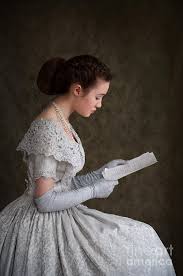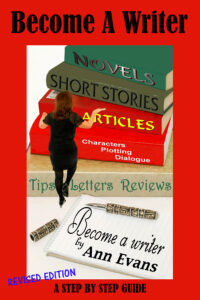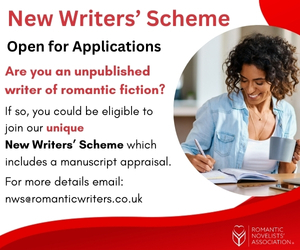Ann Evans: Hints & Tips For New Writers #6
22 September 2020
 Readers of romantic novels want to be swept up in the passion developing between the two main characters – and for the sake of making this easy for me, let’s say it’s heroine and hero. It doesn’t have to be of course, there are plenty of same sex books out there and a big demand for them, but seeing as I haven’t written anything in that genre, I’ll stick with a typically heterosexual romance for this blog.
Readers of romantic novels want to be swept up in the passion developing between the two main characters – and for the sake of making this easy for me, let’s say it’s heroine and hero. It doesn’t have to be of course, there are plenty of same sex books out there and a big demand for them, but seeing as I haven’t written anything in that genre, I’ll stick with a typically heterosexual romance for this blog.
So, a good romance is all about the characters. The heroine is the star of the show, so spend time on really getting to know her. You want the reader to be rooting for her – and of course the hero to fall madly In love with her, so she has to be likable – lovable in fact, so be aware of the traits you endow her with when creating her. Bad tempered, domineering, selfish, heartless are not in her make-up – unless of course, it’s an act, some pretence she’s putting on for reasons best known to herself (until she shares them with the reader).
Likewise, the hero very often comes across as aggressive, proud, brutish, maybe even downright nasty – but sexy (dammit) and charismatic and despite her better judgement, irresistible.…. But I digress. And again, those aggressive traits aren’t really the true him, merely her perception of him, or circumstances, with good reason behind his fierce/unpleasant behaviour.
It hardly seems fair that the man can get away with murder – so in this day and age, I would guard against making the man too Alpha Male. Remember that as well as your heroine falling in love with him, you as the writer need to also fall for him and so do the readers.
You’ve created your characters, and you’ve given them different goals and ambitions which clash with one another in some way. You’ve put them in a scenario where they are forced into a closeness that neither of them chose. Possibly it’s love at first sight for one or even both of them; possibly it’s instant dislike for one of them or both. But now the circumstances they find themselves in means they have to be in each other’s company and talk to one another!
And here comes the tricky bit. What they say, do and think is what will let the reader know they are falling in love. And I really think all three aspects of writing are as important as each other. The conversations they have with each other, the thoughts going through the viewpoint character’s head at the time – possibly contradictory to what’s being said, or possibly far more intense and emotion packed than the brief words that leave their lips; and then the narrative showing their movements, their body language, the quiver of a chin, the head turning aside, the withdrawal of a hand, the way his fingertips linger on her skin… and so on.
The words you choose for your characters to say will most likely be concerned with the plot and what is actually going on in the story. To begin with these won’t be relaxed, loving snippets of conversation, they may be brusque, to the point, argumentative, revealing the conflict and problems to come. So, remember the rules of dialogue and make every word be there for a reason.
Remember too the mood of both of these characters at this point. Neither of them have just been beamed down from Mars, their minds will be on the matter in hand, their mood generated by whatever they’ve just been doing – and now they are faced with this other person! Keep their mood true to them. As the story progresses, it’s important you are aware of how each character is feeling – that is, feeling about the situation in hand, and the situation concerning this other person.
Keeping their temperament consistent is, I think, an important part of making the story believable. If you loose track of how the hero or heroine is feeling, the overall emotional effect of the story might be fragmented rather than strong and powerful.
Use the senses as you write – or rather, let your characters use their senses. Smell, touch, taste, are as powerful as seeing and hearing.
I think in the first meeting of the two, like or loathe each other, there needs to be some strong emotion. And as love grows, you show the slowly changing attitudes by their thoughts, and the narrative as you describe how they are feeling. Plus, the things that they do because their feelings are growing towards this other person. Possibly, the words they say to one another will be the last in the line-up as things develop.
When it comes to sweet talk – if it comes to sweet talk, again, stay close to the characters, let the words they speak feel right for them. If it sounds clunky or cringy to you, then be guided by your instincts. Stay true to the character. And in passionate love scenes, be very careful about mentioning ‘body parts’! It’s far more romantic and erotic to describe how the person is feeling emotionally rather than physically. So just because they are making love, don’t think you have to write about the ‘naughty bits’.
I just wanted to mention here, if you ever get chance to attend the talk by RNA writers Liam Livings and Virginia Heath and their imaginary Fanny and Roger characters, they will have you in stitches just talking about this very subject. At the RNA 2018 Conference they had 200 romance writers literally crying with laughter as they showed us how not to write love scenes!
But back to the plot, and they do say the ‘other half’ is always last to know. And usually, the final dramatic point is where it seems that these two people who the reader knows absolutely adore one another, seem beaten by circumstances. Only as they battle through that bleakest moment and finally fall into each other’s arms and speak those words of love does the dialogue become the most important aspect – and action of course – setting the scene the readers have longed to happen for the last couple of hundred pages. But you save the best till last – and let them say those final magical words…
Happy writing and stay safe everyone
Ann
 Ann Evans writes romance under the name of Ann Carroll, she also writes thrillers, books for children, YA and reluctant readers. She is also a freelance feature writer for various magazines.
Ann Evans writes romance under the name of Ann Carroll, she also writes thrillers, books for children, YA and reluctant readers. She is also a freelance feature writer for various magazines.
Website: www.annevansbooks.co.uk
Facebook: https://www.facebook.com/annevansbooks/
Twitter: https://twitter.com/annevansauthor

Become a Writer.
Find more writing tips in Ann Evans’ book, Become a Writer – a step by step guide.
https://amzn.to/2un61ju



